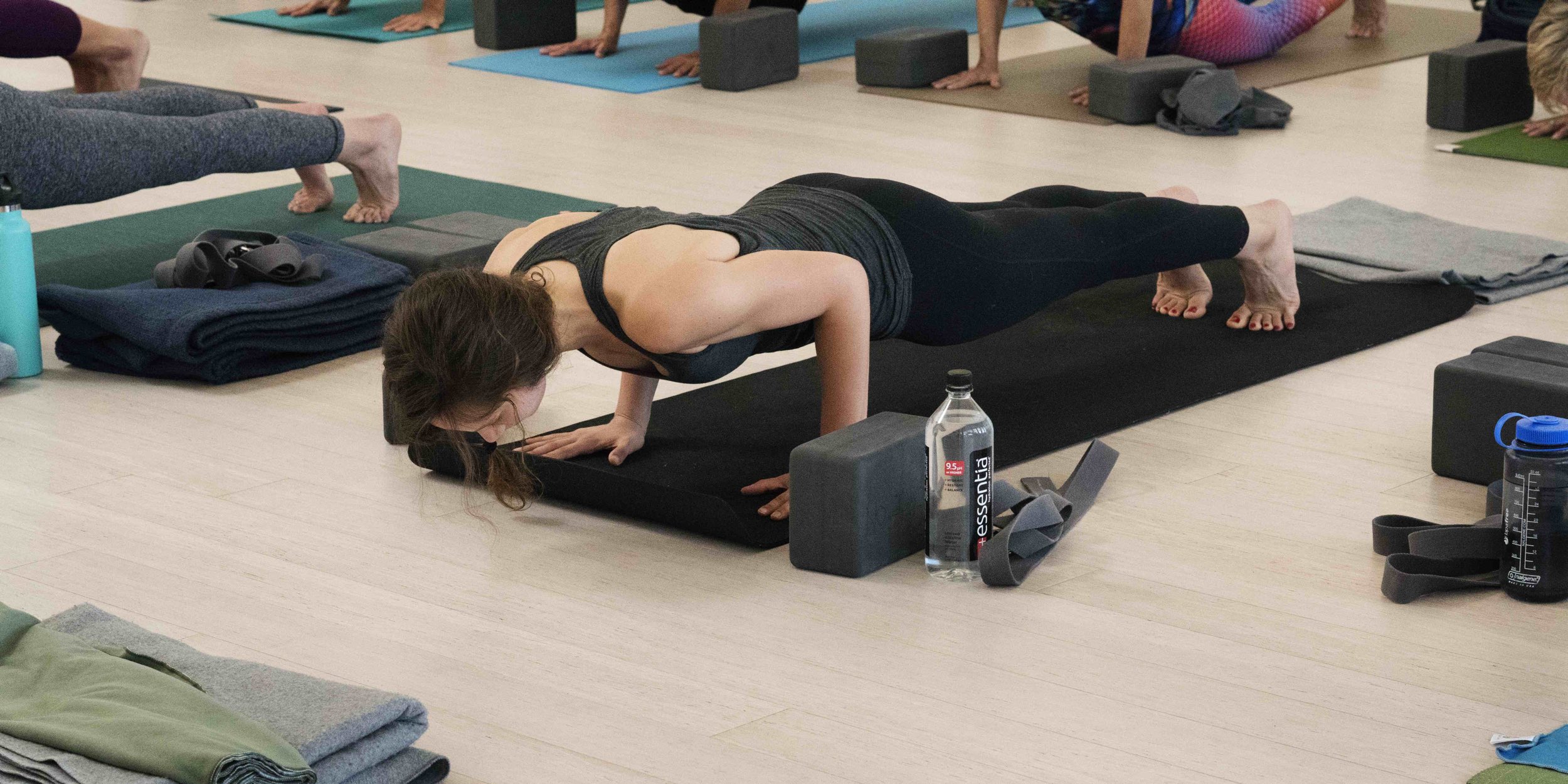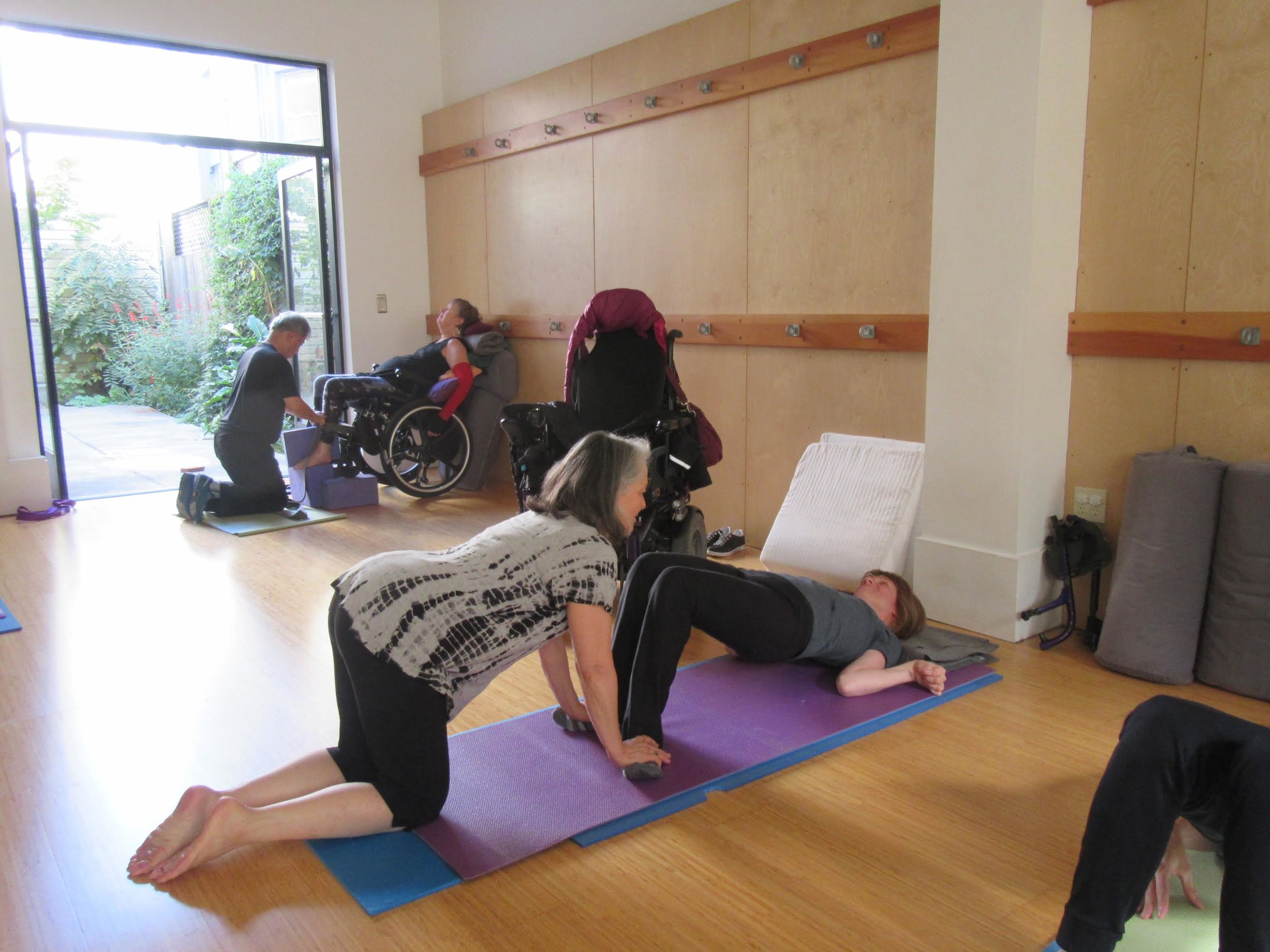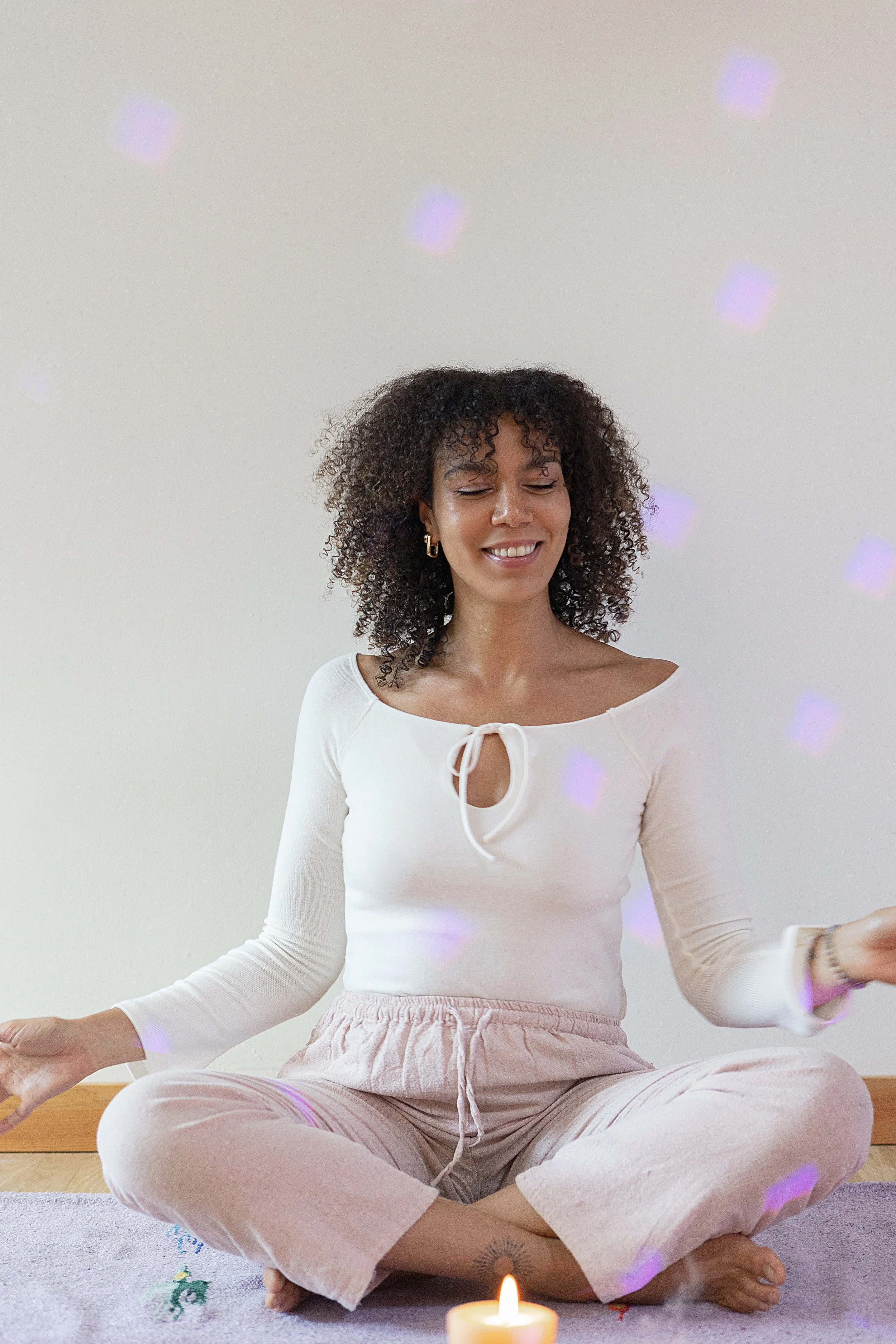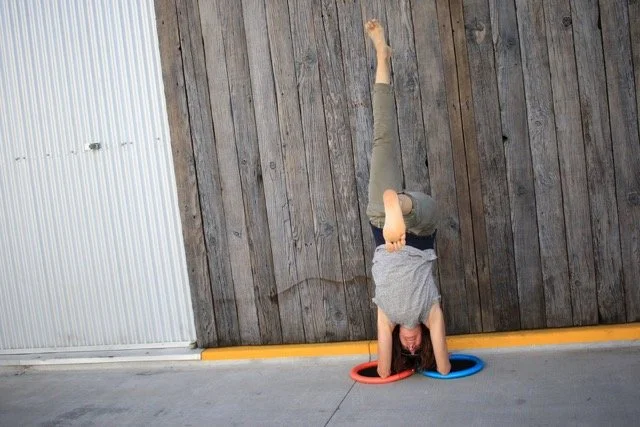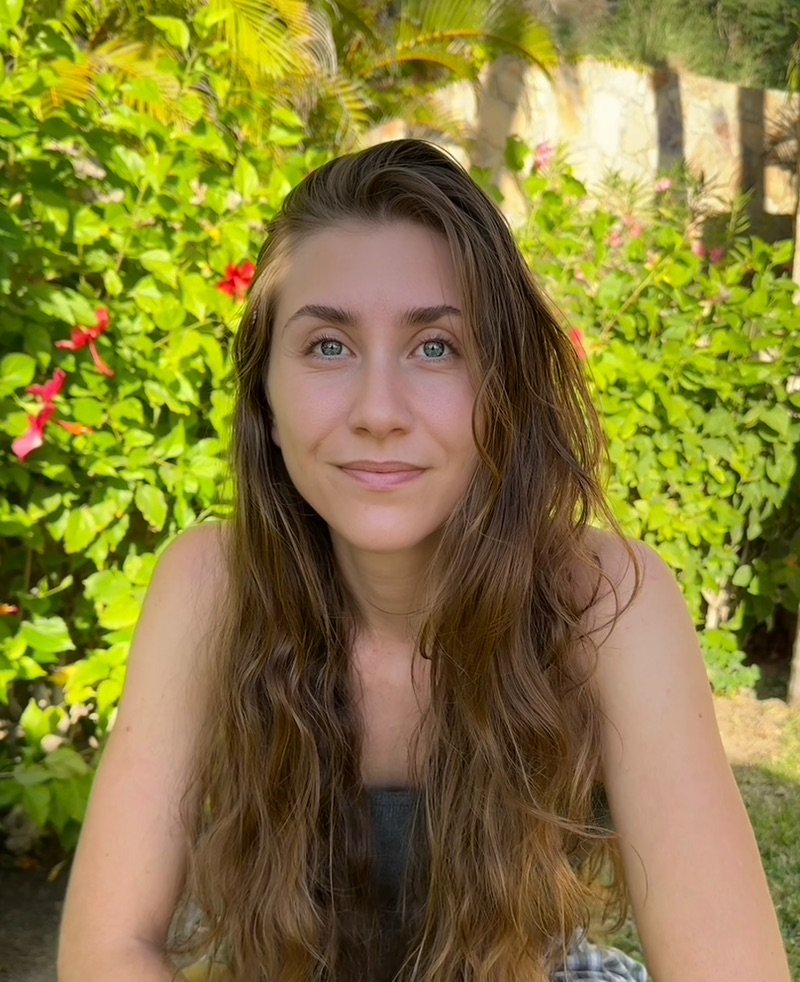
YOGA BLOG
What Moves Us…..
RICHARD ROSEN’S ASANA BREAKDOWN NO.2: CHATURANGA DANDASANA
CHATURANGA DANDASANA (chah-tur-ANG-ah dun-DAHS-anna)
chaturanga = four limbs (chatur = four; anga = limb) (SPELLING NOTE: The Sanskrit “c” is pronounced like the “ch” in “church.” Properly then, “chatur” should be spelled “catur.” The “h” has been added to make the pronunciation easier for non-Sanskritists).
danda = staff (refers to the spine, the central “staff” or support of the body)
Four-limb Staff Pose (the “four limbs” refers to the pose’s four supports, the two hands and two feet)
1. From Adho Mukha Shvanasana (Downward Facing Dog Pose), swing your torso forward into Plank Pose. 1 Align your shoulders over your wrists (so the arms are perpendicular to the floor), and firm your shoulder blades against your back torso. With the torso parallel to the floor, lengthen your tail bone toward the heels.
2. On an exhale, bend your elbows and slowly lower your torso and legs to within a few inches of the floor. It’s common in this pose for the lower back to sag toward the floor and the tail bone to poke up toward the ceiling. To counter this, firm (but don’t tuck) the tail bone toward the pubic bone, and firm the lower belly to bring the navel and the pubic bone closer together. Alternatively, if you lack the strength to hold the torso/legs off the floor, then it’s acceptable to bend the knees to the floor for extra support.
3. Broaden your shoulder blades and hold the upper inner arms close to the sides of the torso, don’t let the elbows splay. You can stay on the balls of your feet or swing slightly forward onto the tops of your feet with the toes pointed back.
4. As you do with Downward Dog, firm the bases of the index fingers against the floor. Beginners should look down at the floor, more experienced students can look forward as long as the back of the neck doesn’t get compressed.
5. Chaturanga Dandasana is one of the positions in the Sun Salutation sequence. You can also practice this pose by itself, holding anywhere from 15 seconds to a minute. When you’re ready to exit, release yourself to the floor with an exhale. Alternately, you could press back on an inhale to Downward Dog; just be sure not to arch back and compress the lower back. Keep the spine long and press back from the top thighs.
Benefits:
Strengthens the arms and wrists
Tones the lower abdomen
Contraindications:
Wrist injury or carpal tunnel syndrome
Beginner’s Tip:
In Plank, position a block on one of its sides (about 4 inches high) under each shoulder; each thumb should touch the end of the block that faces toward you, each index finger is then placed alongside the outside face of the block. Slowly lower your shoulders onto the blocks. If you need more support, position a third block under your thighs. You should then ideally be well supported and can get a feel for what the completed pose is like.
Intermediate’s variation:
In Chaturanga, rock back slightly, then quickly, on an exhale, hop yourself slightly up and forward, landing a few inches ahead of where you started. Continue for a few more forward hops, then try to hop backward, back to where you started. This is called Nakrasana (knock-RAHS-anna), which Mr Iyengar calls the Crocodile, but which may also mean Alligator.
1 NOTE. “Plank” is what this pose is typically called in English; however, if we want to “Sanskrit it up” we can call it “phalakasana” (pa-la-KAHS-anna; the “ph” pronounced like the “p” in “pin” or “path”), phalaka = plank.
PARIGHASANA BY RICHARD ROSEN
PARIGHASANA (par-ee-GOSS-ah-nuh)
parigha = an iron bar or beam used for locking or shutting a gate. Also (depending on context): a line of cloud crossing the sun at sunrise or sunset; two birds flying on each side of a traveller (regarded as an omen); a virtuous person.
This pose is commonly known as the Gate Bar or Gate Latch Pose. Among the 198 poses in Light on Yoga (see p. 73, plates 37-39), it’s one of the true side bends (or more technically a lateral bend). What does this mean? In Triangle Pose (trikonasana) for example, the torso is extended to the side over the forward leg, but the attempt is made to lengthen both sides of the torso evenly. In Parighasana, the torso is curved to the side over the straight leg, so that the underside of the torso is compressed and the topside is fully stretched.
For this pose, you’ll need a thickly folded blanket to serve as a pad for your knee. I also recommend using a wall to support the sole of the side-stretched leg. The pose described immediately below is a simplified variation of the full pose (see plate 38). See the VARIATION section for a description of the full pose (plate 39).
1. Kneel on the floor with your right side to the wall. Stretch your right leg out to the right and press the heel to the floor and the ball of the foot to the wall, toes pointing up (you may also pad the heel if needed). Keep your left knee directly below your left hip (so the thigh is perpendicular to the floor), and align your right heel with the left knee. Turn your pelvis slightly to the right (so the left hip point comes slightly forward of the right), but turn your upper torso back to the left. Turn your right leg laterally to point the knee cap toward the ceiling.
2. Inhale your arms out to your sides, parallel to the floor, palms down. Side-bend to the right over the plane of the right leg and lay your right hand down on the shin, ankle, or on a block outside the right foot. Contract the right side of the torso and stretch the left. With your left hand on the outer left hip, push the pelvis down toward the floor. Then slip the hand up to the lower left ribs and lift them toward the shoulder, opening a wide space in the left waist.
3. With an inhale, sweep the left arm over the back of the left ear. The side bend tends to twist the torso toward the floor. Without pushing the bent-knee hip back (continue to roll it slightly forward), turn the upper torso away from the floor, in this case to the left.
4. Stay in this pose anywhere from 30 seconds to a minute. Come up with an inhale, reaching through the top arm to draw the torso upright. Bring the right knee back beside the left, and repeat with the legs reversed.
Benefits
Stretches the sides of the torso and spine
Stretches the hamstrings of the side leg
Opens the shoulders
Stimulates abdominal organs and lungs
Contraindications: With any serious knee injury, kneeling might be difficult to impossible. In such a case perform this pose sitting on a chair. Arrange your legs either in front of your torso, knees at right angles; or stretch one leg out to the side, mimicking the full pose.
Variation: Full Parighasana is a deep side bend. From the starting position described in step 2 above, lean to the side over the straight leg. Lower the underside of the torso as close as possible to the top of the straight leg. Press the back of the lower hand on the top of the foot, then sweep the top arm over the back of the ear and join the palms. Finish as described in step 4 above.
Preparatory Asanas
Adho Mukha Svanasana
Baddha Konasana
Prasarita Padottanasana
Supta Padangustasana
Upavistha Konasana
Utthita Parsvankonasana
Utthita Trikonasana
Virasana
Follow-up Asanas: Parighasana can be used as a preparation for many of the standing poses, like Trikonasana and Parsvakonasana. It’s also a good preparation for Parivrtta Janu Sirsasana.
Beginners Tip: If you tend to hyper-extend your knees, brace a block under the calf of the side leg to prevent any compression of the knee.
CLASSES FOR EVERYBODY BY JOANN LYONS
I’m guessing if you’re reading this, you love your yoga class! It’s something you count on and look forward to every week, knowing that you’ll not only learn something about your body or how to nail that perfect pose, but also that you’ll feel so much better after your class and spending time with other people of like mind. Finding strength, flexibility, relaxation in a pose, or even nailing that perfect pose is not the exclusive domain of able-bodied yogis, although sometimes it sure appears that way. Twenty, even ten years ago, it was the rare exception to find a class that was inclusive of the disability community; yoga studios, usually located upstairs, were not accessible. On April 1, 2001, Piedmont Yoga Studio opened its doors with an accessible studio on Piedmont Avenue and began offering classes for people with disabilities. My name is JoAnn Lyons and I was, and still am, the teacher of two classes each week that have lasted through ownership and name changes, as well as a new physical location of the studio. In order to provide a positive experience for students, I’ve been providing teacher trainings so that our students receive expert help when needed. Piedmont Yoga Community (PYC), a non-profit organization, was formed to support these classes, and to supplement payment to teachers for this important work, so the classes can be offered to our students on a sliding scale. These yoga classes for People with Disabilities are meant to be inclusive. No one is turned away because of race, color, creed, sexual orientation, gender identity, age, ability, disability or lack of ability to pay for the class. And therein lies the rub . . . PYC is asking for help from the local yoga community to support these classes. If you can make a one-time donation or, better still, commit to a monthly contribution, it would help PYC support this work. If you have other ways to help by donating your time and talent, please contact PYC. Here are some quotes from our students and assistants and their thoughts on how PYC has touched their lives.
“Thank you for your wonderful class and your generosity and devotion to a group of people with limited options and a need for all the help they can get . . .” Joel B.
“Thank you so much for doing this at an affordable rate . . .” ♥ Joan C.
“The class has helped me move closer to the life I desire – a life of being present, conscious and happy.” Patricia E. “In short, the class has a very cool vibe!” Melissa C.
“The community that inevitably develops in any class . . . keeps bringing me back.” Patrice W.
“Shared companionship and compassion before, during or after every class, making it very unique and gratifying.” Ramona A.
“I feel so safe at your Yoga classes. The amount of personal, individual attention each participant receives is extraordinary in my experience.” Marty S.
THE GARDEN: LIFE, DEATH AND PERSPECTIVE BY JODY HAHN
I love my garden. I love my garden so much. When I first planted it I watered diligently and watched closely to see how each plant was doing. I swear I went out to look at it about 10 times a day, maybe more. Many plants survived, some did not. That’s life and death in the garden, I guess. The ones that did survive now flourish; there is so much abundance it’s crazy, and to that abundance flock many other creatures. I see them around my garden vying for their bit of life: I watch, joyfully, as the birds, bees and butterflies travel around getting what they need to survive. And I watch, horrified, as the leaf-miners, aphids, and white flies suck the life out of the plants. Argh!! It’s a paradox. For something to live something else has to die. This is the cycle of life!! I call them MY vegetables but nature says different. It’s every-creature-for-themselves out there. We’re all part of this grand thing called nature and I have to say, I respect my competitors; they want to feast and so do I. Yes, there is competition but there is also enough for everyone. There’s actually more than enough! Nature’s true nature is abundance and we can give, take, share and thrive. Through competition nature keeps balance. What may seem like destruction is just part of the cycle that also creates. What seems like a nuisance in the microcosm is actually necessary in the macrocosm. That “bad” is actually “good”. Can I recognize this in all aspects of life? Can I see that I am part of this continuous whole? Can I be just as happy to give to the birds, bees, and butterflies as to the leaf-miners, aphids and white flies and understand that they’re all getting what they need and giving what is needed? Yes, I’ll try.
RICHARD ROSEN’S ASANA BREAKDOWN NO. 9: VĪRABHADRĀSANA 3
ASANA BREAKDOWN: VĪRABHADRĀSANA 3
(veera-bah-DRAS-anna)
by Richard Rosen
vira = brave person, hero
bhadra = blessed, auspicious, prosperous, happy, etc.
Popularly known as Warrior Pose, 3rd variation (abbreviated below as V3)
Virabhadra’s Pose, often called Warrior (variation 3). This pose is usually entered from Virabhadrasana I. Here we’ll move into the pose from a straight lunge position.
1. Stand in Tadasana, exhale and lower down to Uttanasana, then exhale again and step your left foot back into a lunge position. Your right knee should be more or less at a right angle. Lay your torso down on the top of the right thigh and bring your hands to your right knee, right hand to the outer knee, left hand to the inner. Then squeeze the knee, lift your torso slightly, and with an exhale, turn it slightly to the right. Lay the middle of your torso (from the pubis to the sternum) down on the middle of the right thigh (from the knee to the hip crease).
2. Normally students come up into Virabhadrasana III by lunging the torso forward. This tends to shift the body weight onto the ball of the front foot and unbalance the pose. So don’t let your torso swing forward as you move into pose; instead, as you straighten the front knee, think of pressing the head of the thigh bone back. This centers the femur in the hip joint, grounds the heel into the floor, and stabilizes the pose. At the same time, when you straighten your front knee, resist the calf forward against the shin. These two opposing movements–femur head back, calf/shin forward–prevents the knee from locking and further stabilizes the position.
3. Now from the lunge position, stretch your arms forward, parallel to the floor and parallel to each other, palms facing. Exhale and, as described previously, press the head of your right thigh bone back and the heel actively into the floor. Synchronize the straightening of the front leg and the lifting of the back leg. Resist the lift of this leg by firming your tail bone against the pelvis.
4. The arms, torso, and raised leg should be positioned relatively parallel to the floor. For many students the pelvis tends to tilt toward the standing leg side. Release the raised-leg hip toward the floor until the front plane of the pelvis is also parallel to the floor. Reach strongly back though the raised leg, and just as strongly in the opposite direction with the arms. Bring the head up slightly and look forward, but be sure not to compress the back of your neck.
5. Stay in the pose for 30 seconds to a minute. Release back to the lunge on an exhale, bring your hands to the floor on either side of the right foot, and with an exhale, step your left foot forward beside your right back into the forward bend. Stay here for a few breaths, then repeat for the same length of time with the legs reversed.
- Benefits
Strengthens the ankles and legs
Strengthens the shoulders and muscles of the back
Tones the abdomen
Improves balance and posture
-Beginners’ tip: For beginners balance in this pose can be very challenging. Prepare for the pose with a chair positioned in front of you, just a bit in front of your sticky mat (face the back of the chair toward you). When you stretch your arms forward (as described in step 3 above), take hold of the top of the chair back. As you rise up into the full pose, push on and slide the chair away from you and use it to support your arms. Try to hold the chair as lightly as possible.
- Advanced Tip: Advanced students can enter Virabhadrasana III from Virabhadrasana I. Perform the latter pose with the arms stretched upward. Exhale the front torso down onto the top of the forward leg. From here move into Virabhadrasana III as described in step 3 above.
- Partnering: A partner can act as a support for your pose. Have her stand in front of you. When you reach your arms forward just before lifting into the full pose, she should lightly hold your wrists in her hands. She should guide you up into position, and then support your wrists as lightly as possible.
Our Blog
Check out the latest Articles:

